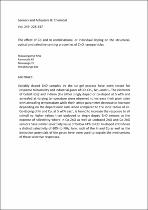 ResearchSpace
ResearchSpace
The effect of Co and In combinational or individual doping on the structural, optical and selective sensing properties of ZnO nanoparticles
JavaScript is disabled for your browser. Some features of this site may not work without it.
- ResearchSpace
- →
- Research Publications/Outputs
- →
- Journal Articles
- →
- View Item
| dc.contributor.author |
Maswanganye, MW

|
|
| dc.contributor.author |
Rammutla, KE

|
|
| dc.contributor.author |
Mosuanga, TE

|
|
| dc.contributor.author |
Mwakikunga, Bonex W

|
|
| dc.date.accessioned | 2018-02-01T08:31:13Z | |
| dc.date.available | 2018-02-01T08:31:13Z | |
| dc.date.issued | 2017-08 | |
| dc.identifier.citation | Maswanganye, M.W. et al. 2017. The effect of Co and In combinational or individual doping on the structural, optical and selective sensing properties of ZnO nanoparticles. Sensors and Actuators B: Chemical, vol. 247: 228-237 | en_US |
| dc.identifier.issn | 0925-4005 | |
| dc.identifier.uri | https://www.sciencedirect.com/science/article/pii/S0925400517302599 | |
| dc.identifier.uri | https://doi.org/10.1016/j.snb.2017.02.039 | |
| dc.identifier.uri | http://hdl.handle.net/10204/10014 | |
| dc.description | Copyright: 2017 Elsevier. Due to copyright restrictions, the attached PDF file only contains the abstract of the full text item. For access to the full text item, please consult the publisher's website. | en_US |
| dc.description.abstract | Variably doped ZnO samples by the sol-gel process have been tested for response to humidity and industrial gases of CO, CH(sub4), NH(sub3) and H9sub2). The elements of Cobalt (Co) and Indium (In) either singly doped or co-doped at 5 wt% and annealed at varying temperature were observed to increase their grain sizes with annealing temperature while their lattice parameter decrease or increase depending on the dopant ionic radii when compared to the ionic radius of Zn. Co-doping of In and Co, at 5 wt% each, is found to increase the response to all stimuli to higher values than undoped or singly doped ZnO sensors at the expense of selectivity where In-Co-ZnO as well as undoped ZnO and Co-ZnO sensors have similar selectivity value of below 44% to CO. In-doped ZnO shows a distinct selectivity of 60% to NH(sub3). Ionic radii of the In and Co as well as the ionization potentials of the gases have been used to explain the mechanisms of these selective responses. | en_US |
| dc.language.iso | en | en_US |
| dc.publisher | Elsevier | en_US |
| dc.relation.ispartofseries | Worklist;20177 | |
| dc.subject | Combinational | en_US |
| dc.subject | Doping | en_US |
| dc.subject | Cobalt | en_US |
| dc.subject | Indium | en_US |
| dc.subject | ZnO | en_US |
| dc.subject | Gas sensor | en_US |
| dc.title | The effect of Co and In combinational or individual doping on the structural, optical and selective sensing properties of ZnO nanoparticles | en_US |
| dc.type | Article | en_US |
| dc.identifier.apacitation | Maswanganye, M., Rammutla, K., Mosuanga, T., & Mwakikunga, B. W. (2017). The effect of Co and In combinational or individual doping on the structural, optical and selective sensing properties of ZnO nanoparticles. http://hdl.handle.net/10204/10014 | en_ZA |
| dc.identifier.chicagocitation | Maswanganye, MW, KE Rammutla, TE Mosuanga, and Bonex W Mwakikunga "The effect of Co and In combinational or individual doping on the structural, optical and selective sensing properties of ZnO nanoparticles." (2017) http://hdl.handle.net/10204/10014 | en_ZA |
| dc.identifier.vancouvercitation | Maswanganye M, Rammutla K, Mosuanga T, Mwakikunga BW. The effect of Co and In combinational or individual doping on the structural, optical and selective sensing properties of ZnO nanoparticles. 2017; http://hdl.handle.net/10204/10014. | en_ZA |
| dc.identifier.ris | TY - Article AU - Maswanganye, MW AU - Rammutla, KE AU - Mosuanga, TE AU - Mwakikunga, Bonex W AB - Variably doped ZnO samples by the sol-gel process have been tested for response to humidity and industrial gases of CO, CH(sub4), NH(sub3) and H9sub2). The elements of Cobalt (Co) and Indium (In) either singly doped or co-doped at 5 wt% and annealed at varying temperature were observed to increase their grain sizes with annealing temperature while their lattice parameter decrease or increase depending on the dopant ionic radii when compared to the ionic radius of Zn. Co-doping of In and Co, at 5 wt% each, is found to increase the response to all stimuli to higher values than undoped or singly doped ZnO sensors at the expense of selectivity where In-Co-ZnO as well as undoped ZnO and Co-ZnO sensors have similar selectivity value of below 44% to CO. In-doped ZnO shows a distinct selectivity of 60% to NH(sub3). Ionic radii of the In and Co as well as the ionization potentials of the gases have been used to explain the mechanisms of these selective responses. DA - 2017-08 DB - ResearchSpace DP - CSIR KW - Combinational KW - Doping KW - Cobalt KW - Indium KW - ZnO KW - Gas sensor LK - https://researchspace.csir.co.za PY - 2017 SM - 0925-4005 T1 - The effect of Co and In combinational or individual doping on the structural, optical and selective sensing properties of ZnO nanoparticles TI - The effect of Co and In combinational or individual doping on the structural, optical and selective sensing properties of ZnO nanoparticles UR - http://hdl.handle.net/10204/10014 ER - | en_ZA |





